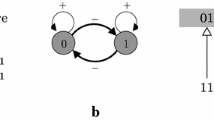Abstract
The study of relationships between structure and dynamics of asynchronous Boolean networks has recently led to the introduction of hereditarily bijective maps and even or odd self-dual networks. We show here that these two notions can be simply characterized geometrically: through orthogonality between certain affine subspaces. We also use this characterization to study operations preserving hereditary bijectiveness, and to provide effective methods for constructing hereditarily bijective maps and even or odd self-dual networks.






Similar content being viewed by others
References
Chaouiya C, Remy E (2013) Logical modelling of regulatory networks, methods and applications. Bull Math Biol 75:891–895
Cima A, Gasull A, Mañosas F (1999) The discrete Markus–Yamabe problem. Nonlinear Anal 35:343–354
de Jong H (2002) Modeling and simulation of genetic regulatory systems: A literature review. J Comput Biol 9(1):67–103
Demongeot J, Elena A, Sené S (2008) Robustness in regulatory networks: a multi-disciplinary approach. Acta Biotheor 56(1–2):27–49
Dennunzio A, Formenti E, Provillard J (2012) Non-uniform cellular automata: classes, dynamics, and decidability. Inf Comput 215:32–46
Goles E, Salinas L (2008) Comparison between parallel and serial dynamics of Boolean networks. Theor Comput Sci 396:247–253
Kauffman SA (1969) Metabolic stability and epigenesis in randomly constructed genetic nets. J Theor Biol 22:437–467
Kauffman SA (1993) The origins of order: self-organization and selection in evolution. Oxford University Press, Oxford
Remy E, Ruet P (2007) On differentiation and homeostatic behaviours of Boolean dynamical systems. In: Transactions on computational systems biology VII, Springer LNCS, vol. 4780, pp. 92–101
Remy E, Ruet P (2008) From minimal signed circuits to the dynamics of Boolean regulatory networks. Bioinformatics 24:i220–i226
Remy E, Ruet P, Thieffry D (2008) Graphic requirements for multistability and attractive cycles in a Boolean dynamical framework. Adv Appl Math 41(3):335–350
Richard A (2012) A fixed point theorem for Boolean networks expressed in terms of forbidden subnetworks. In: Cellular automata and discrete complex systems, DMTCS Proceedings
Richard A, Ruet P (2013) From kernels in directed graphs to fixed points and negative cycles in Boolean networks. Discrete Appl Math 161:1106–1117
Ruet P (2014) Local cycles and dynamical properties of Boolean networks. Math Struct Comput Sci. doi:10.1017/S096012951400036X
Ruet P (2014) Geometric characterization of hereditarily bijective Boolean networks. In: Asynchronous cellular automata and asynchronous discrete models, Springer LNCS, vol. 8751, pp. 536–545
Shih M-H, Dong J-L (2005) A combinatorial analogue of the Jacobian problem in automata networks. Adv Appl Math 34(1):30–46
Snoussi EH (1989) Qualitative dynamics of piecewise-linear differential equations: a discrete mapping approach. Dyn Stab Syst 4(3–4):565
Thomas R (1973) Boolean formalization of genetic control circuits. J Theor Biol 42:563–585
Thomas R (1981) On the relation between the logical structure of systems and their ability to generate multiple steady states and sustained oscillations. In: Series in synergetics, vol. 9. Springer, pp. 180–193
Thomas R (1991) Regulatory networks seen as asynchronous automata: a logical description. J Theor Biol 153:1–23
Thomas R, Kaufman M (2001) Multistationarity, the basis of cell differentiation and memory. I. Structural conditions of multistationarity and other non-trivial behaviour. Chaos 11:170–179
von Neumann J (1966) Theory of self-reproducing automata. University of Illinois Press, Champaign
Author information
Authors and Affiliations
Corresponding author
Rights and permissions
About this article
Cite this article
Ruet, P. Asynchronous Boolean networks and hereditarily bijective maps. Nat Comput 14, 545–553 (2015). https://doi.org/10.1007/s11047-015-9523-4
Published:
Issue Date:
DOI: https://doi.org/10.1007/s11047-015-9523-4




